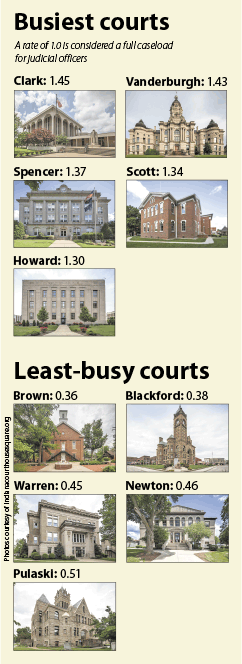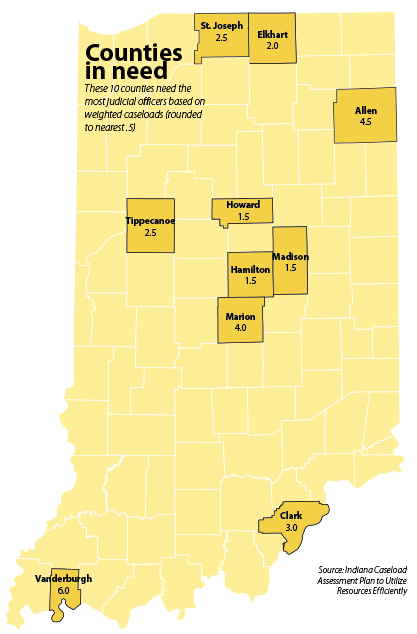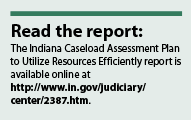Subscriber Benefit
As a subscriber you can listen to articles at work, in the car, or while you work out. Subscribe NowVanderburgh County needs six more judicial officers. Courts in Allen and Marion counties each need at least four more, and Clark County needs three. Elkhart, St. Joseph and Tippecanoe courts all need at least two more.
The short-staffing illustrated in the largest and most thorough weighted caseload study of the state’s trial courts may be met in the future, but not likely without cuts elsewhere. Rep. Greg Steuerwald, R-Danville, told a legislative study committee Sept. 22 that appointment of new state-paid judicial officers should be tied to reducing numbers of officers where they are underutilized.
“I’m hearing from the fiscal people,” Steuerwald told a meeting of the Interim Study Committee on Courts and the Judiciary. The panel received copies of the study, for which Indiana Chief Justice Loretta Rush said nearly 100 percent of judicial officers statewide kept detailed time records for the month of October 2015.
The data analyzes how busy state trial courts are and where resources are most needed — or not. Balancing those scales, though, presents challenges.
“I would hate to see the General Assembly precipitously acting on a study that just came out,” said Lake Superior Chief Judge John Pera, reacting to its finding that the second-largest county’s 34 judicial officers are almost 3.5 more than needed on a weighted caseload basis. “This is a challenge for all of us, and the challenge is to have a system of justice the public has confidence in and is credible, and I think in the long run we’re going to figure this out.”
 Busy or not?
Busy or not?
Overall, the Indiana Caseload Assessment Plan to Utilize Resources Efficiently report says 17 new judicial officers are needed statewide. “That’s a very modest need in my view, and it’s going to take some cooperation within the judiciary to allocate judicial officers in an equitable way to handle the caseloads,” Pera said.
The report distills data judicial officers captured last October, producing a snapshot of court needs in every county. Using a formula of weighted caseloads divided by the time for available judicial officers in each county to work on them, Clark County retains its long-held status of most overworked circuit.
Supreme Court Chief Administrative Officer Mary Willis explained the county’s utilization rate of 1.45 means each judge or magistrate in Clark County on average is handling 45 percent more cases than they should under a weighted caseload standard. Right behind is Vanderburgh County, with a rate of 1.43.
On the other end of the spectrum, Brown and Blackford counties report the state’s lowest utilization rates of just 0.36 and 0.38, respectively. While Brown County has just a judge and a magistrate and Blackford County just two judges, the study says that’s one officer too many in each county. Likewise, the study says Newton and Pulaski counties in northern Indiana have 2 judicial officers apiece and roughly the work for just one. Rural Pulaski County has been the subject of prior bills to study eliminating one of its judgeships.
 Steuerwald’s charge to approve new judicial officers by reducing numbers elsewhere won’t be easy, though. Aside from Lake County, most of the adequately staffed counties are small and rural, with one to four judicial officers. The data, though, may make a case for reductions in some of those circuits.
Steuerwald’s charge to approve new judicial officers by reducing numbers elsewhere won’t be easy, though. Aside from Lake County, most of the adequately staffed counties are small and rural, with one to four judicial officers. The data, though, may make a case for reductions in some of those circuits.
Allen Circuit Judge Tom Felts, who sits on the study committee and the courts’ strategic planning committee, said he understands the desire to add judicial officers where needed by subtracting from counties where the data show under-utilization. “But the numbers don’t work out that way,” he said, since so many are counties with just one or two judges.
“Chief Justice Rush has certainly adopted a theory that we judges probably best know our own caseloads and how to handle them, and let us work on these issues on our own,” Felts said. He said his caseload in circuit court with two magistrates is manageable, but the study says Allen County’s 23 judicial officers are carrying a caseload that should require 27.6 judges and magistrates.
He said local rules help balance case-loads, whether dockets are moved between superior courts or between superior and circuit court. “All of us working together address any issues that may present themselves,” Felts said.
Creative solutions
Willis said judges are working on creative solutions, including helping out in neighboring counties. She noted, for instance, that underutilized judges in Blackford and Jay counties have agreed to help out with cases in neighboring Delaware County. Other options include sharing resources for problem-solving courts and increased use of senior judges.
“It is going to represent a cultural shift, I think, in how we conduct our business,” Pera said. “Back in the old days, a judge never left his county. … We do run a statewide judicial system, at the end of the day.
“It’s something new we have to take a look at, get accustomed to, and figure out a way to make it work.”
Meanwhile, Clark County may be getting some relief. The study panel recommended appointment of a new magistrate, but Clark Circuit 4 Judge Vicki Carmichael said that’s really a Band-Aid. “We’d really like to have two new courts,” she said, but local funding and facilities wouldn’t be available to support the request.
Clark County has four circuit courts and three magistrates, but the study shows the county across the Ohio River from Louisville needs another 3.16 judicial officers. The panel also recommended a new magistrate for Shelby County, ranked 11th most in need of additional judicial resources according to the study.
Meanwhile, the Supreme Court promptly enacted one of the key recommendations from the report. On Sept. 23, the court issued an order creating new case types for domestic relations cases with children (DC) and those without (DN), beginning Jan. 1. The order also creates new tax-sale case types.
 Willis said there was broad consensus on these changes, because they will help courts better allocate resources for matters on which judges and magistrates on average said they lacked sufficient time — child in need of services cases, termination of parental rights cases, and domestic relations cases where children are involved.
Willis said there was broad consensus on these changes, because they will help courts better allocate resources for matters on which judges and magistrates on average said they lacked sufficient time — child in need of services cases, termination of parental rights cases, and domestic relations cases where children are involved.
Pera advocated caution, noting case filings ebb and flow and the tide is unpredictable. Just more than 1.4 million cases were filed in trial courts in 2014, roughly 40 percent fewer than the 2 million filed in 2008. “We don’t want to wholesale eliminate or shift around judicial officers,” he said. “Filing patterns shift over time.”•
Please enable JavaScript to view this content.
